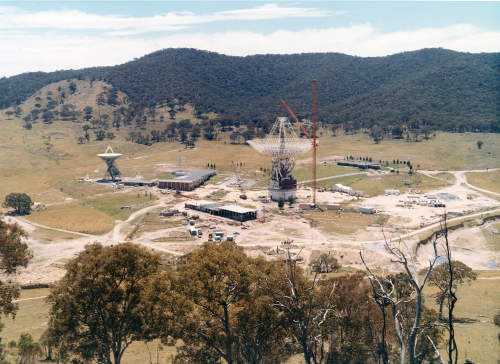
Keith Aldworth
Island Lagoon Minitrack, Tidbinbilla, Parkes
I left school at the age of fifteen, in the U.K. and joined the R.A.F. as
a Boy Entrant at Cosford. I trained as an Air Radar Mechanic and passed out
as a Senior Aircraftsman in 1961. In 1962, I retrained as a Ground Radar Fitter,
was promoted to Junior Technician and served at RAF Bawdsey, a control and reporting
radar station on the East coast of England. In November 1964, I purchased my
discharge from the RAF and applied for emigration to Australia.
I came to Australia in early 1965 and went to Woomera, where I joined the team at Island Lagoon, on the Minitrack station. This facility shared the area with a Baker Nunn Camera and DSS 41, Deep Space Tracking Station.
When Minitrack moved to Orroral Valley, near Canberra, I was offered a position at Tidbinbilla, DSS42.
Very shortly after arriving at Tid, I met Jan, and a magical courtship ensued. We have now been married for over forty years. We have two children: one is a Landscape architect working in Scotland and the other CEO of a financial services company in Melbourne.
I started at Tid early in 1966 as a technician ‘A’,
working on mission dependent equipment for the first Pioneer mission. From there,
I went to analogue instrumentation and recording, including video.
 |
Keith Aldworth – at Parkes. |
When the Apollo missions began, Tidbinbilla’s 64 metre antenna had not been built and as we all know, Parkes Radio Telescope was seconded to NASA for periods of about six weeks around the Apollo missions. At the Parkes site, the equipment necessary for these missions was installed and remained there throughout. A team of people from Tid was detailed to man the Parkes site. I was not on that team until Apollo 14 and I was nominated to take the place of Mil Perrin, who no longer wished to be away from home for the extended periods necessary. My responsibility there was for telemetry and video recording and the ground communications to Canberra.
During the lead up to missions, the group travelled up to Parkes to prepare and install equipment. We commuted weekly and stayed in either, The Coach House Motel, or The Park View Motel. At weekends, we went home to Canberra.
The two motels had their advantages and disadvantages. The Park View was a little bit out of town and the Coach House was in the centre of town. The two specialised in different cuisines. The Park View’s steaks were superb, whereas the Coach House served wonderful seafood.
During the pre-mission periods, we preferred to stay at the Coach House but during the mission periods, the peace and quiet of the Park View was preferred.
We worked for up to sixteen hours per day during the actual mission periods and did not get to go home until the mission was completed and our equipment de-commissioned.
As the Tidbinbilla grew and equipment became more digitally oriented, I moved onto telemetry and command processors and became a senior digital technician ‘C’.
During construction of the 64 metre antenna, everyone took on whatever tasks were assigned and I can remember miserable hours of running thousands of cables in the cold plenum and installing rigid and awkward Spiro line cables in the tunnel that went between the Ops Room and the Antenna. We worked hard, but with great excitement, as we watched this megalith arise from the bottom paddock. What an amazing piece of engineering it is, floating on a film of oil, as its main bearing.
 |
The enormous 64 metre antenna of DSS43 nears completion. |
Working in an environment where everything was new all of the time and where great discoveries and achievements were constantly being made, was something that I had never anticipated in earlier life. I felt privileged to be a part of it and I am sure that the majority of my colleagues felt the same. It was more than a team spirit. I would liken it more to a family spirit. Of course, there were occasional misfits but they were only blips in the overall scheme of things.
After Apollo and having the use of the new 64 metre antenna, Tid really took off with deep space exploration. Mariner missions to Mars, Vikings, Pioneers, out to deep space and even out of the Solar System. It was all interesting and exciting.
The end of that period of my life came quite abruptly. One morning after a night shift, we were driving home and had just reached the Cotter when I was gripped by agonising pain in my midriff. I was driving at the time and had to pull the car over to the side of the road. Someone took over the driving and delivered me to the then new, Woden Hospital, where I was admitted and treated for a haemorrhaging duodenal ulcer. I underwent surgery and a few weeks of recuperation before returning to work with medical advice to put an end to working shift work. I set about finding alternative employment.
Very quickly, I was accepted to manage and supervise an electronics workshop in the Department of Electrical and Computer Engineering at the University of Queensland. I took up this position in August 1977 and Jan and our son Joined me in October. We lived in the Brisbane suburb “The Gap”.
I remained in this position at U.Q. until I retired in September
1998, although we had moved our residence from The Gap, to Bribie Island, where
we built a home in which to retire. After four years at Bribie, at the time
of my retirement, we decided that it was not really where we wanted to be so
we moved to Noosa, on the Sunshine Coast, where we remain and enjoy the fruits
of our working lives.